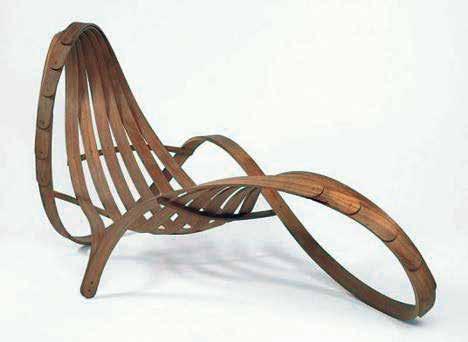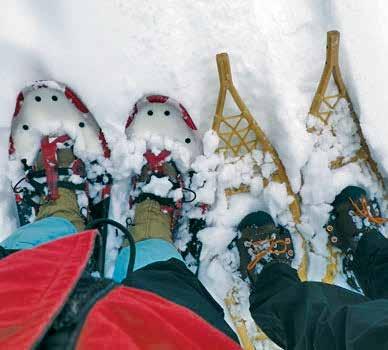
8 minute read
Walking on air and snow A PRIMER ON SNOWSHOES AND SNOWSHOEING
BY DARREN BUSH
Once upon a time in Central Asia, some prehistoric inventor watched his friends trudge through deep snow in hot pursuit of a tasty mammoth. A snowshoe hare went bounding by and the neolithic equivalent of a light bulb went off.
Advertisement
Homo ingenious slapped a few pieces of wood on the snow and tied them on his feet. Rudimentary, but he got to the mammoth first and ate well.
For thousands of years, native people in North America have been using snowshoes as fourwheel drive for their feet. For these people, snowshoes were critical to survival. The Inuit didn’t use snowshoes, as many people think – they mostly walked on ice. Snowshoes came into use further south where deep snow made travel impossible without flotation.
Voyageurs and trappers learned quickly from the indigenous people the benefits of traveling by snowshoe. Later, the effectiveness of snowshoes wasn’t lost on the military. Decisive victories were won by the British during the Seven Years War due to their superior snowshoes. Some troops were issued both skis and snowshoes during the Second World War and their effectiveness as a fighting force was enhanced
by their ability to go where others couldn’t. Today’s trappers use smaller, more manoeuvrable shoes on their trap lines. In Scandinavia some letter carriers still deliver mail by snowshoe.
As I build and repair traditional shoes, I’ve become a bit of a magnet for people who find an old pair in the family garage. Here’s what I’ve learned. SNOWSHOE CONSTRUCTION 101
The purpose of this section is not to teach you how to build a pair of shoes but to make you aware of the basics, so you understand your equipment better and maybe be inspired to make your own.
Snowshoes are a simple concept. Weight distributed over a larger area doesn’t sink as much into the snow. All things being equal, where I might sink to my knees in my boots, I would sink only to my ankles as the snowshoes compress the snow.
The traditional wood for snowshoe frames has always been ash – it’s durable and easy to shape. Ash staves are split out of a log and worked down to size with a drawknife or crooked knife, following the grain so the frame doesn’t crack when it bends. After the staves are shaped, the wood is steamed to soften the lignin, the stuff which acts as a glue holding together the wood fibers. Steam it too much and you cook out the lignin; too little and it won’t bend. It takes a practised hand and a few ruined frames to learn how to do it.
Here’s a chair created by U.K. design students (next page). Yes, it is wood. Amazing.

Once the wood is soft and flexible, it’s time to clamp it onto a form shaped to create your snowshoe in the style you want, with lots of places to clamp the wood in place. This must be done quickly (you have about a minute) or the lignin starts to harden and you may have to re-steam or start over. Let the wood rest on the form for an hour or so and you have a snowshoe’s outer frame.
The traditional material for lacing is leather cut into thin strips called babiche. It’s a species of rawhide that softens when soaked in water and hardens as it dries. It can be thick or thin, but whatever it is, working with it is like weaving linguini.
The patterns can be quite open with thick lacing, or very fine with thin, almost string-like lacing. The tighter the weave, the better the flotation, so for powdery snow a tighter weave is best. Some of the patterns woven by my two favorite shoe builders, the Attikamek and Eastern Cree, are works of art. Function and beauty go together perfectly.
A nice combination of ancient and contemporary is to use wood frames but modern material for the lacing. Sliced neoprene and flat nylon webbing both work well, are more durable, and can be more forgiving. Babiche needs to be kept varnished to keep it from softening on contact with moisture, and to keep it from wearing out.
Generally the foot bed is laced last. This is the area right underneath your foot and is made with thicker and more durable lacing material, whatever it might be. Snowshoe tips and tails are usually a finer size and have a tighter weave. The pattern is fairly simple and anyone can do it with a little practice.
Whether it be nylon or babiche, the shoes need to be varnished to waterproof both frames and lacing. A good spar varnish (from a marina store, not a generic home centre) is more flexible and lasts longer. Slather it on and keep going until it doesn’t absorb any more.
Bindings attach your feet to the shoes, allowing the heel to lift while keeping the ball of your foot over the pivot point. Bindings range from a simple piece of lamp wick to a formed leather or neoprene harness that hugs your foot. The tails drag, keeping the shoes facing forward. I like leather because it’s durable, snow doesn’t stick to it and it doesn’t get stiff in the cold.


MODERN CHANGES
Modern shoes are a far cry from the wood-and-leather hand-built snowshoes of the last half dozen millennia. Frames of aluminum and even titanium became the order of the day, with decks made of neoprene or similar materials. They come with injection-molded toe pieces and built-in crampons, those claw-like teeth that grab the snow with a serious bite.
>>
SPRING THROUGH WINTER WITH ATLAS SPRING-LOADEDTM SUSPENSION SNOWSHOES.


ATLAS SNOWSHOES. DESIGNED TO GO THERE.

YOUR DESTINATION FOR AN ACTIVE LIFESTYLE
5607 Hazeldean Road 613-831-3604
203 Richmond Road 613-792-1170
> bushtukah.com
Bindings are more sophisticated too. The shoes on the left in the photo (top of page) are moderns from Crescent Moon, and you can see a red plastic binding with two black straps across the top of the boot. modern bindings really snug down around the foot right over the crampon. They are more complex, and that has advantages and disadvantages. The advantage is adjustability, but complex things break more often.
But in general the upside of the modern shoe is that they require less maintenance. Metal frames and plastic decks and bindings don’t wear out if used properly. The crampons are excellent when freezing alternates with thawing, making a slippery snow surface for traditional shoes. Because they are smaller and narrower, your stride can be more natural. Models made for running in the snow are available too; they’re as small and light as possible, which means less floatation but more mobility.

DID YOU KNOW? Winter weather
If you’re trying to plan your winter sport schedule, check the stats. According to weatherspark.com, statistically the coldest day of the year in Ottawa is Jan. 19, with an average low of -15°C and high of -6°C. The chances of there being snow on the ground are highest around Jan. 8, occurring 65 per cent of the time; and snow is typically at its deepest on Feb. 9. Just so you know.
The downsides? Aesthetics, for one. No one hangs a pair of modern shoes over the fireplace. They can be squeaky, and without the crampons the deck material is slippery. Modern shoes tend to be smaller, so you sink a little more in light snow.
I own both kinds and use them both in different conditions. In my area of the world where hills are gentle and snow is generally fluffy and untracked, I use traditional shoes. When I hike in hilly places, out come the moderns.
Either way, I love poles. Even with the most stable snowshoes, poles provide a measure of balance that makes snowshoeing easier for novices, and gives you a boost up hills. They also add a little upper body workout and some serious cardio. I also use them sometimes as a sort of impromptu monopod for taking pictures in low winter light. THE ZEN OF THE SNOWSHOE
In the fast-paced world, we need something to slow us down. Cross-country skiing used to be a fairly leisurely activity, but the Lycra crowd came in with skate skiing and things accelerated. Not that there’s anything wrong with that: a nice long skate feels good, like a nice long run feels good. But everything moves faster now.
I’m not sure if the need for slowing down is the reason, but snowshoeing has passed Nordic skiing in growth and shows no signs of slowing down. I find myself carrying a small pack and walking rather than skiing, checking out the birds and seeing more than I would if I were focusing on balance and staying on track.
For winter camping, snowshoeing is ideal for pulling

a toboggan-load of gear. Weight and bulk become non-issues with a toboggan, and a night in a heavy canvas tent with a small woodstove in it is as comfortable as anyone can expect in the wilderness. When it’s hot inside the tent and frigid outside, it’s almost cheating. Almost.
Try it out. Build, buy, or borrow a pair and get out there. Strap on snowshoes, leave the world behind, and enter the quiet stillness of the woods in winter.











